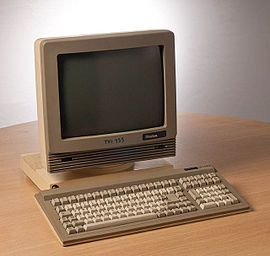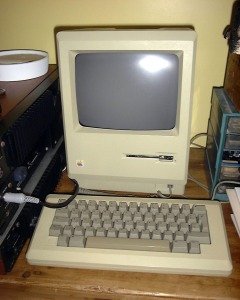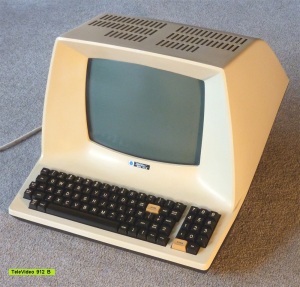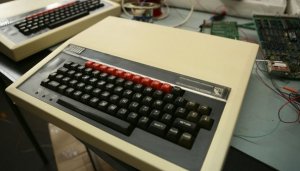Back in the early days of the Oxford Poly Distributed Asynchronous Network, PR1ME services were accessed using dumb terminals by Televideo and other manufacturers, or via a terminal emulator on a microcomputer (there were one or two IBMs kicking around in Computer Services as well as suites of BBC Micros in locations like S212 (Science Building) and the Wheatley Campus.
Here are a few of the Terminal / Micro models you’d commonly find across the Poly / Brookes campus.
Name: Televideo TVI 910 / 912
Distinguishing characteristics: Flip top head, brick-like keyboard, easy to carry under one arm
Colour: Dirt-stained white or Baby-sick beige.
Locations: G108 (Gibbs Block), CC1, CC2 and CC3 (initially) and an awful lot of dead ones tucked under my bench in the Batcave
History: The Televideo 910s and 912s were usually shuttled off to the less popular pooled room locations around the Headington Campus (though a few did fetch up at Wheatley Campus in offices etc, and there was even a lone TVI912 stuffed into the Squash Courts for the online booking system – that worked as long as rats hadn’t eaten the asynch link between the Squash Courts and the “Swiss Chalet” (CMS). From a technical perspective, these things were sturdy and could take a heck of a bashing and from a technician perspective they were handy because you could lump one under one arm to carry around and still have a hand free to open doors 🙂
Name: Televideo TVI 925
Distinguishing characteristics: Common as muck. Separate keyboard meant carrying one was a challenge (they were bloody heavy too!). Some came with an additional numeric / crosspad for some indeterminate use / reason
Colour: Filthy fingernail white
Locations: DG25 (Gibbs Block), CC1, CC2 and CC3 (after most of the 912s died), Boiler House rooms (BH1, BH2 and BH3), Wheatley Portakabin (god that place was ALWAYS freezing) and in a lot of admin / finance offices

The TVI 925 was probably what most people at The Poly remember using. They were quite commonly found in most of the pooled computer rooms and were fairly reliable. The keyboards were as tough as old boots and could stand up to even the most frenetic typing from grubby computer technicians! Useless fact: I tried to retrofit a TVI925 keyboard with old letter ‘tops’ from Smarties and various staff and students contributed their own Smartie tube tops to the project (which sadly never saw the light of day, alas!)
Name: Televideo TVI 950 / 955
Distinguishing characteristics: Smooth scrolling, relatively thin ‘tube’, nice keyboards, on-off switch on front (whoah!). Smooth scrolling too (but this made me feel seasick!)
Colour: John Major Grey with a ribbed-for-your-pleasure front screen bezel.
Locations: H106 (Catering) and a select few admin offices

 These were the ‘posh’ terminals and an awful lot of students sneaked over to the Catering Computing Room (H106) to sneakily use these. Mainly because the TVI950 / 955s had quite nice ‘touch’ keyboards for slick typists. The control panel options allowed for various setups (we only used the green screen ones at the poly but others had mono displays as shown above). A smooth scrolling option could be enabled but this made you feel really sick after a few hours of use. You could also invert the display from green on black to black on green (but imagine the eyestrain!)
These were the ‘posh’ terminals and an awful lot of students sneaked over to the Catering Computing Room (H106) to sneakily use these. Mainly because the TVI950 / 955s had quite nice ‘touch’ keyboards for slick typists. The control panel options allowed for various setups (we only used the green screen ones at the poly but others had mono displays as shown above). A smooth scrolling option could be enabled but this made you feel really sick after a few hours of use. You could also invert the display from green on black to black on green (but imagine the eyestrain!)
Name: Televideo TVI 965
Distinguishing characteristics: Wow, it’s like something from the FUTURE, maaan!
Colour: Ice White
Locations: Programmers Corridor and (of course) the Head of Computer Services’ office as well as a few secretarial / HR / Finance locations. No surprises the big cheeses kept the best terminals for themselves!
Slick, smooth, lovely keyboards – these were the “Rolls Royce” of terminals and you very rarely saw them in student pooled facilities. Mostly these were kept closetted away in admin and finance offices or for heads of department! I did manage to purloin one for use in the Batcave for a while but I actually didn’t like the keyboard that much, it felt a bit too flimsy! Various models were available including one with an amber on black display. Fancy!
Name: BBC Model B
Distinguishing characteristics: GAMES! Oh and a terminal emulator written by Steve Walters that allowed the usual access to the Asynchronous Network.
Colour: Beige with lovely red function keys.
Locations: CC2, S212, Wheatley Campus and one was used for a Ceefax-style display system in the Computer Corridor (written partially by Adam Marriott and partially by me!)
Most people of a certain age will remember these hulking great big microcomputing behemoths with fondness for various reasons. 1) You could play Elite on them (and I lost count of the amount of hooky copies of Elite that were distributed around the student body while working at the poly) 2) You could make silly noises with them and 3) you could stick an eprom socket on them for various fun things. We used these in several locations for experiments etc (in fact in my current job these are STILL in use for a couple of the earthquake simulation rigs). The BBC Micros in various locations could also access the asynchronous network via an emulator written by the late great Steve Walters, a systems administrator and programmer at Oxford Polytechnic in the 80s / Early 90s. Steve also wrote a lot of the other software and front ends in use around the plot. One BBC Micro was used for the ‘driver’ behind a rudimentary display system between CC2 / CC3, powered by a Ceefax-based info system partially written by Adam Marriott (head of the Comms team) and myself (I wrote a piece of code to just dish up a series of pages in succession – probably the first piece of programming I did at the place)
Name: Apollo Graphics Workstation
Distinguishing characteristics: Too expensive for you, monkeyboy!
Colour: Beige
Locations: DG38 Engineering Graphics Lab
This is about the closest approximation to the Apollos that were in use at The Poly. A fairly large CAD suite had a collection of these, along with their digitiser pucks and tablets…
Users would painstakingly dot-plot graphics to bring into whatever cad packages were used at the time (mostly some HP software). I remember a programmer (Anne Black) kidnapping one of these from the lab but dropping it on her foot. Unsurprising really as these things were huge and weighed a ton. Owch!
Name: Apple Macintosh Classic
Distinguishing characteristics: Dinky, portable, cute and I LOVED mine (still have a thing for Apple stuff but then who doesn’t!)
Colour: Beige / Khaki.
Locations: Visual Studies Department, Programmers Corridor, Batcave, Student Union Office
 The Apple Macintosh was seen as something of a ‘quirky’ beast during my early years at The Poly. One or two were dotted around in various locations (notably, the Student Union Office had one or two more beefy Macsfor putting together The Last Edition – the student magazine, along with copies of Quark Express or Pagemaker). I used a Mac and Mac Paint to produce some of the first posters that went up and around in computer rooms when we first started using PCs (Students would use really crap quality floppy disks, and the disk shutters would ‘spring’ and get stuck in the drives of the old RM Nimbus PCs in use in pooled rooms). I came up with a series of posters entitled “Uses for a dead diskette” (and I think I’ve still got these around at home somewhere, I’ll try and dig them out).
The Apple Macintosh was seen as something of a ‘quirky’ beast during my early years at The Poly. One or two were dotted around in various locations (notably, the Student Union Office had one or two more beefy Macsfor putting together The Last Edition – the student magazine, along with copies of Quark Express or Pagemaker). I used a Mac and Mac Paint to produce some of the first posters that went up and around in computer rooms when we first started using PCs (Students would use really crap quality floppy disks, and the disk shutters would ‘spring’ and get stuck in the drives of the old RM Nimbus PCs in use in pooled rooms). I came up with a series of posters entitled “Uses for a dead diskette” (and I think I’ve still got these around at home somewhere, I’ll try and dig them out).
I borrowed the Computing Services Mac (along with its 10mb external drive – yes, a whopping TEN MEG of storage, wooh!) and got a bit carried away with customising the UI (old Macs would allow you to customise the mouse pointers, various system messages etc). I don’t think the person who inherited it from me was very impressed with having to use a Mac with a custom Tank Girl pointer (but she didn’t know how to change it back, hah!)
Later I was seconded to the Visual Arts department as temporary technical cover, and these macs were still in use over there right up to around 1995.






